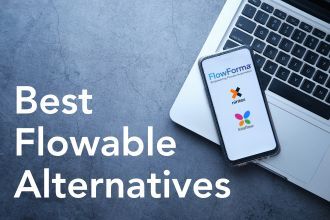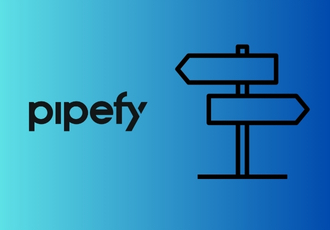Workflow automation is essential for businesses striving to improve efficiency and streamline processes.
However, if you're feeling limited by automation tools like Flowable—whether due to its complexity, steep learning curve, or pricing structure—you're not alone. Many organizations are now exploring alternatives for managing workflows that offer better flexibility, ease of use, and faster implementation.
This article is your guide to the top 10 Flowable alternatives. We’ve carefully selected these platforms based on key criteria like features, integration options, scalability, and ease of use.
Why Look for Flowable Alternatives?
 Flowable Homepage
Flowable Homepage
Flowable is a powerful business process automation platform widely recognized for its flexibility and scalability. However, businesses are increasingly looking for alternatives due to specific limitations that can hinder efficiency and increase costs.
Below are the key reasons why organizations are considering Flowable alternatives:
1. Steep learning curve
While Flowable is feature-rich, it can be challenging for non-technical users. The platform’s reliance on BPMN 2.0 and coding for advanced features means that users without a background in process modeling or development often face difficulties in getting the most out of the tool.
2. Difficulties in navigation
Several users have reported that the Flowable platform can be challenging to navigate, especially for those unfamiliar with its complex interface. The layout and user experience may not be as intuitive as other platforms, requiring users to invest time in learning how to find and use the right tools effectively.

3. Opaque Pricing
Flowable’s pricing is not publicly available on its website, and platforms like Capterra list it at $99 per user per month. This may not be ideal for businesses looking to scale their processes. In addition, the AI Studio is separately licensed, which adds to the overall costs.
10 Best Alternatives to Flowable in 2025
Here’s a curated list of the top Flowable alternative software that helps solve the aforementioned pain points and streamline your workflows with ease.
|
Tool |
Learning Curve |
Integration Options |
Ease of Use |
|
FlowForma |
Low |
Microsoft 365, ERP, CRM, thousands of systems |
High (No-code, intuitive) |
|
Camunda |
Medium |
Java, REST APIs, external task workers |
Medium (requires technical expertise) |
|
Appian |
Medium |
Salesforce, SAP, Oracle |
High (Low-code with intuitive design) |
|
Kissflow |
Low |
Google Workspace, Zapier, CRM |
High (Low-code, simple design) |
|
Workato |
Medium |
Salesforce, Workday, ServiceNow |
Medium (No-code but advanced) |
|
Bonita BPM |
High |
REST APIs, external services |
Medium (Requires technical setup) |
|
Nintex |
Medium |
SharePoint, Salesforce, SAP |
Medium (Low-code, somewhat complex) |
|
Bizagi |
Medium |
SAP, Salesforce, SharePoint |
High (No-code, drag-and-drop) |
|
Pega |
High |
SAP, Salesforce, Cloud |
Medium (Requires technical resources) |
|
ProcessMaker |
Low |
ERP, CRM, HRM tools |
High (No-code, simple interface) |
Top 10 Flowable Alternatives in 2025
Here’s a detailed look at the best Flowable alternatives, along with their key features, pros, and cons.
1. FlowForma
 FlowForma’s homepage
FlowForma’s homepage
FlowForma is a leading AI-powered, no-code platform designed for business process automation, enabling users to create, automate, and optimize workflows without needing coding expertise.
Ideal for mid-sized companies and enterprises looking to streamline operations, FlowForma integrates seamlessly with Microsoft 365 and other third-party tools. With a strong focus on ease of use and transparent pricing, FlowForma allows businesses to digitize complex processes faster than ever.
FlowForma Key Features
1. Ease of Use
FlowForma’s no-code platform allows business users to design, automate, and optimize workflows without any coding expertise.
 Why are no-code platforms easier to use compared with low-code platforms
Why are no-code platforms easier to use compared with low-code platforms
With its intuitive drag-and-drop interface, building processes becomes as simple as selecting steps, adding rules, and connecting tasks.
This simplicity enables employees across various departments, from HR to finance, to automate complex workflows without relying on IT, reducing bottlenecks and empowering teams to take control of their automation needs.
2. AI-Powered Automation
FlowForma’s AI suite goes beyond traditional automation by providing tools that assist workflow creation, execute intelligent actions, discover optimization opportunities, and summarize progress in real time.
 Benefits of AI automation
Benefits of AI automation
AI Copilot: The Copilot allows users to create workflows using natural language or process diagrams, eliminating the need for coding or complex configurations. By simply describing the process in plain English, the AI instantly builds the workflow structure, including steps, rules, and logic.
Video showcasing the AI Playground
Agentic AI: The Agentic AI feature is designed to perform autonomous, intelligent actions within workflows. It can read documents, extract data, validate information, and route outputs to the correct systems, dramatically reducing manual input.
Watch FlowForma’s AI Masterclass to learn all about building workflows using AI
Discovery Agent: The Discovery Agent provides a fast and seamless way to capture processes from voice conversations, meetings, and everyday tasks, ensuring no detail is lost. By turning discussions and informal work into automated workflows, businesses can skip the time-consuming process of manual documentation or workshops.
 FlowForma’s Discovery Agent
FlowForma’s Discovery Agent
3. Microsoft Integration
FlowForma offers seamless integration with Microsoft 365 and SharePoint Online, enabling users to automate workflows directly within the Microsoft ecosystem.
.png?width=640&height=480&name=FlowForma%20ai%20integration%20image%20(2).png) FlowForma integrations
FlowForma integrations
4. Data Security
Data security is a top priority for FlowForma. The platform stores data in your organization’s own SharePoint tenancy, giving you full control over your data. This provides a significant advantage when it comes to compliance, as businesses in regulated industries like finance, insurance, or healthcare can manage sensitive information securely within their existing infrastructure.
5. Seamless Workflow Automation
FlowForma enables businesses to create seamless workflows with minimal effort. Its workflow engine allows users to design complex, multi-step processes with ease.

FlowForma’s workflow automation benefits
Whether it’s for client onboarding, expense approvals, or contract management, FlowForma offers a visual process mapping tool that simplifies the creation and management of workflows.
Watch this demo to see how FlowForma automates the client onboarding process in financial services:
Onboard clients seamlessly by creating onboarding workflows using FlowForma
6. Document and Form Management
FlowForma automates the creation, population, and management of both documents and forms directly from workflow data.
Whether it’s a contract, invoice, audit report, or compliance certificate, FlowForma’s automated document generation feature dynamically populates templates with real-time information captured throughout the workflow. This ensures that documents are always accurate and compliant, reducing manual effort and minimizing errors.
 FlowForm automates document generation at scale
FlowForm automates document generation at scale
In addition to document generation, the tool also allows businesses to build dynamic forms that adapt to the progress of the workflow. These forms capture all necessary data in real time, ensuring consistency across all stages of the process.
FlowForma Pros
- Intuitive, drag-and-drop interface
- Built-in compliance module to ensure adherence to regulations like DORA, ISO, GDPR, and HIPAA
- Advanced reporting and real-time insights
- Transparent pricing with no hidden costs
- Extensive AI suite, including Copilot, Agentic AI, summarization, smart assistant, and discovery agent
FlowForma Cons
- Requires a Microsoft 365 and SharePoint environment
FlowForma Pricing
FlowForma follows a transparent, process-based pricing model. This enables mid-sized and large companies to scale their automation efforts without incurring hidden costs.
Here’s the complete pricing breakdown.
What users are saying about FlowForma
 User testimonial for FlowForma from G2
User testimonial for FlowForma from G2

User testimonial for FlowForma from G2
2. Camunda

Camunda homepage
Camunda is an open-source platform built to handle complex business process automation tasks. Known for its flexibility and advanced BPMN 2.0 support, Camunda is often favored by technical teams looking to integrate process orchestration with Java or external task workers.
Camunda Key Features
- BPMN 2.0 engine for business process modeling
- Advanced task management with Java and external task integration
- High scalability with open-source and enterprise versions
- REST APIs for seamless integrations
- Open-source community and documentation
Camunda Pros
- Flexible and customizable
- Strong open-source community support
- Scalable architecture for large organizations
- Good integration with Java and external services
Camunda Cons
- Requires technical expertise to use effectively
- Steep learning curve for non-technical users
- Not suited for businesses with limited development resources
3. Appian
 Appian’s low-code development platform
Appian’s low-code development platform
Appian is a low-code automation platform that blends process automation with powerful decisioning tools and artificial intelligence. Known for its quick deployment and user-friendly interface, Appian is favored by businesses that need a fast, intuitive solution for automating workflows with minimal IT involvement.
Appian Key Features
- Low-code development for process modeling
- Integration with a wide range of enterprise systems
- AI-powered decisioning tools
- Real-time reporting and analytics
- Cloud-native architecture for scalability
Appian Pros
- Fast deployment and time-to-value
- User-friendly interface for business users
- Strong integration capabilities with various platforms
- Ideal for both simple and complex workflows
Appian Cons
- It can be expensive for small to medium-sized businesses
- Some features require developer expertise for full customization
- Limited customization for highly specialized workflows
4. Kissflow
 Kissflow’s low-code development platform
Kissflow’s low-code development platform
Kissflow is a low-code workflow automation platform designed to simplify process management for small to mid-sized businesses. It provides tools for automating everything from simple tasks to complex workflows, all within an intuitive interface that requires minimal coding knowledge.
Kissflow Key Features
- Drag-and-drop workflow automation
- Project management and document management capabilities
- Integration with popular apps like Google Workspace and CRM tools
- Real-time analytics and reporting tools
- Customizable forms and workflows
Kissflow Pros
- Simple, intuitive user interface
- Quick setup and easy-to-learn platform
- Affordable pricing, ideal for small to medium businesses
Kissflow Cons
- Limited customization for highly complex workflows
- Basic features may not meet the needs of larger enterprises
5. Workato
 Workato homepage
Workato homepage
Workato is a no-code integration and automation platform designed for enterprises. It focuses on connecting disparate systems, automating workflows, and handling complex integrations.
Workato Key Features
- No-code integration platform with automation tools
- Supports hundreds of pre-built integrations with enterprise applications
- Real-time data synchronization across systems
- AI-powered automation for decision-making
- Scalable for complex, enterprise-level automation
Workato Pros
- AI-driven process automation
- Scalable and suitable for large enterprises
- User-friendly interface with drag-and-drop functionality
- Automates workflows across multiple systems
Workato Cons
- Expensive for smaller businesses
- Steep learning curve for non-technical users
6. Bonita

Bonita homepage
Bonita offers an open-source, flexible platform for designing, managing, and optimizing business processes. It's designed for organizations looking to implement process automation with a high degree of customization and scalability.
Bonita Key Features
- Open-source BPMN 2.0 engine
- Customizable workflows and process models
- REST APIs for integrations with third-party applications
- Real-time process monitoring and analytics
Bonita Pros
- Fully customizable to meet specific business needs
- Strong open-source community support
- Flexible and scalable architecture
- Advanced modeling tools for complex workflows
- Good support for integrations with external applications
Bonita Cons
- Requires development expertise for customization
- It can be time-consuming to set up and configure
7. Nintex
 Nintex process automation platform
Nintex process automation platform
Nintex is a low-code workflow automation platform with a focus on enhancing productivity and efficiency. It’s ideal for businesses that need to automate processes within SharePoint, Office 365, and other enterprise applications.
Nintex Key Features
- Workflow automation with SharePoint and Office 365
- Document generation and management capabilities
- Reporting and analytics tools for process tracking
- Integrates with ERP, CRM, and other enterprise systems
- Advanced forms and data collection
Nintex Pros
- Easy-to-use interface with low learning curve
- Good for both simple and moderate workflows
- Reliable mobile support for remote process management
Nintex Cons
- It can be expensive for small businesses
- Limited customization for highly specialized workflows
8. Bizagi
 Bizagi homepage
Bizagi homepage
Bizagi is a no-code business process management and automation tool designed for companies looking to digitize their operations without a steep learning curve. It integrates with enterprise systems like SAP and Salesforce.
Bizagi Key Features
- No-code platform for automating workflows
- Advanced process modeling tools
- Real-time process monitoring and analytics
- Built-in collaboration tools for teams
- Customizable reporting and dashboards
Bizagi Pros
- Intuitive, easy-to-use platform for business users
- Fast deployment with no-code interface
- Integration with popular enterprise tools
- Offers support for process monitoring and optimization
Bizagi Cons
- Limited advanced customization options for complex workflows
- Pricing can be prohibitive for smaller businesses
9. Pega
 Pega homepage
Pega homepage
Pega is a customizable business process automation platform that is widely recognized for its strength in enterprise-level process management and decisioning. It offers both no-code and low-code options for building workflows.
Pega Key Features
- BPM and CRM capabilities for end-to-end automation
- AI-powered decisioning and analytics
- Integration with a wide range of applications
- Real-time process monitoring and insights
- Low-code and no-code development options
Pega Pros
- Customizable for complex business processes
- AI-driven decision-making tools
- Strong support for mobile and cloud environments
Pega Cons
- High complexity for non-technical users
- Expensive for mid-sized companies
10. ProcessMaker
 ProcessMaker’s process automation platform
ProcessMaker’s process automation platform
ProcessMaker is a flexible, no-code workflow automation tool that specializes in streamlining business processes. It integrates easily with various third-party applications and offers process modeling capabilities.
ProcessMaker Key Features
- Drag-and-drop workflow design
- Integration with ERP, CRM, and other systems
- Real-time analytics and reporting tools
- Advanced decision-making and routing
ProcessMaker Pros
- Simple, intuitive interface for business users
- Good support for real-time process tracking and analytics
- Scalable for both small and large enterprises
- Mobile support for on-the-go process management
ProcessMaker Cons
- Limited advanced customization for highly complex workflows
- Some features require premium support or add-ons
FlowForma: The Best Flowable Alternative for Business Process Automation
 When looking for a Flowable alternative, FlowForma is the clear leader due to its ease of use, rapid implementation, enterprise features, and transparent pricing.
When looking for a Flowable alternative, FlowForma is the clear leader due to its ease of use, rapid implementation, enterprise features, and transparent pricing.
For businesses seeking to streamline their processes quickly and cost-effectively, FlowForma offers an intuitive platform that meets all the needs of mid-sized and large businesses without the complexities of other low-code or no-code tools.
Here’s a quick recap of the key features that position it as the best business process automation software:
- AI Copilot, Agentic AI, AI Agent, and Summarization
- Real-time reporting and analytics
- Integration with Microsoft 365 and third-party apps
- Transparent, process-based pricing model
- Role-based access control and data security
- No-code process automation
Want to see how FlowForma can improve your workflows? Book a demo today!
 By
By 





